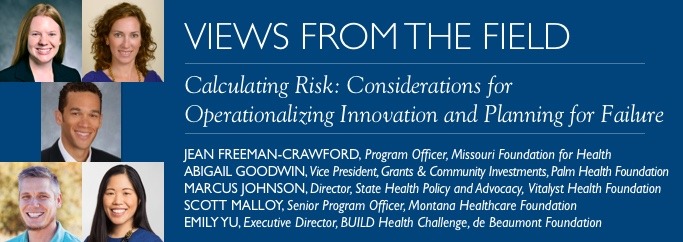
Jean Freeman-Crawford, Program Officer, Missouri Foundation for Health
Abigail Goodwin, Vice President, Grants & Community Investments, Palm Health Foundation
Marcus Johnson, Director, State Health Policy and Advocacy, Vitalyst Health Foundation
Scott Malloy, Senior Program Officer, Montana Healthcare Foundation
Emily Yu, Executive Director, BUILD Health Challenge, de Beaumont Foundation
Philanthropy’s greatest freedom is, perhaps, the freedom to fail. This insight, stated in Terrance Keenan’s monograph (2000), “The Promise at Hand: Prospects for Foundation Leadership in the 1990s,” sparked robust dialogue during the 2018 Terrance Keenan Institute (TKI) for Emerging Leaders in Health Philanthropy.* In his writings, Keenan illustrates a delicate balance philanthropy must continue to hold: on one side, long-standing trust between the public and the philanthropic world; on the other, the industry’s unique freedom to fail when developing creative, yet risky, solutions to some of society’s most intractable problems (Keenan 2000). Fast forward to 2019—it is far more common to find popular talks or writings describing similar notions of “failing fast” and “failing forward.” In theory, this sentiment makes sense—the ability to be agile, experiment, or prototype will expedite deep learning and reveal novel solutions. Such notions are often popularized by disruptive innovations in the world of business and technology, where iterative failures might be measured in terms of financial losses and piles of unsuccessful cell phones. Something, however, feels very different about the risk-reward calculations associated with modern philanthropy’s investments in health. What does “the freedom to fail” mean to health philanthropy in 2019? How can health philanthropy responsibly embrace failure as a catalyst toward innovation? How can we do so in a way that reinforces, rather than risks, public trust?
Historically, some foundations may have experienced “failures” and/or unintended consequences following carefully designed efforts. From 1909-1922, the Russell Sage Foundation (RSF) took a risk by investing a sixth of its capital to build housing for working families in New York City. RSF’s goal was to show that affordable housing near an urban center could be successful. Unfortunately, housing prices increased so dramatically that the beneficiaries could no longer afford to live in that housing. As a result, RSF lost a substantial part of its investment and families lost their homes (Russell Sage Foundation 2019). In another example from 1932, the Carnegie Corporation commissioned a study in South Africa intended to improve living conditions for 300,000 individuals living in poverty. The findings, however, were eventually used by South African leaders to rationalize an apartheid government (Carnegie Corporation of New York 2019).
Failure is not something to be taken lightly, but it also does not mean that we should recoil in face of risk. The concept of failure and risk-taking is nothing new to TKI fellows. On the heels of the Great Recession, the 2012 cohort wrote about the imperative to take risks, arguing periods of societal tumult present the greatest opportunity for philanthropy to step up. And just a few years ago, following one of the most divisive elections in recent history, the 2016 cohort wrote “foundations are designed to be bold,” and urged philanthropy to accept risks associated with addressing health policy.
Today, many of us find ourselves at new crossroads, questioning just how bold our foundations can be. As we broaden our health lens and make our way upstream, we begin to encounter new risks—risks that, once overcome, promise to produce success at a scale yet unseen.
Framing the conversation about risk-taking and failing forward, the 2018 cohort gathered in Washington DC and wrestled with a number of the pressing challenges:
- What are the risks and benefits for health philanthropy to deepen its equity lens?
- As the field builds its policy and advocacy muscle, what are the risks and promises?
- As health philanthropy widens it focus to include social determinants, what are inherent risks given the history of a medicalized approach?
Below are three considerations to help the field embrace strategic and calculated risks for the changes we urgently need while anticipating the inevitable stumbles (big and small) along the way:
Failure Optimization Planning: In a recent Stanford Social Innovation Review piece, Jen Ford Reedy (2018) recommended foundations adopt this planning component as part of a strategy that appreciates the “freedom to fail.” She recognizes that while we cannot control what may happen down the road to a program, we can plan ahead and influence how we might address or react to those shifts. Knowing that changes are likely, especially in various political and environmental contexts of today, developing strategies and frameworks that are nimble, flexible, and designed to allow for pivots could mean the difference between a program that fails, and one that fails forward—yielding something of value to the sector despite the fact it may not have met its original goals. Reedy (2018) suggests that a key example here is securing trust and transparency between funders and grant recipients, partners, and others so there is a shared vision of achieving the most out of an endeavor as opposed to simply meeting a set of predetermined goals.
- Example: Palm Health Foundation’s Healthier Together initiative, a neighborhood, resident-led effort in six communities in Palm Beach County, Florida, prioritizes emergence and adaptive leadership to build localized networks grounded by an iterative learning process. Communities are encouraged to “‘probe-sense-respond’” and develop “‘safe to fail’” projects. They are supported by trusting relationships with foundation staff, intentional reflection and systematic learning to make adjustments accordingly and/or amplify for impact.
Make Failure Matter: When failure happens to you, your organization, you’re collaborative – what will you do? We encourage you to reflect on it and share your insights with your peers. Inspired by the Be Fearless movement championed by Jean Case (2019) of the Case Foundation, she encourages our sector writ large to “fail forward,” and make failure matter. Taking a page from entrepreneurs, Case challenges our sector to take strategic risks and the failures that will come with them. After all, the path of any bold new idea that has the potential to change the world is going to be littered with failures. Key here is to recognize the value in failure, learn from it, and share your lessons with others so it is not repeated without purpose. And in this way, together, we can as a sector advance. Case (2019) notes, “every great innovator has experienced moments of failure, but the truly great among them wear those failures as badges of honor… if everyone commits to sharing lessons from failure, the society as a whole will be stronger and more prepared to attack the next challenge.”
- Example: With the BUILD Health Challenge, a funding collaborative and national awards program designed to advance sustainable improvements in community health, awardees share their progress on a quarterly with BUILD. Challenges, failures, and wins are all raised on a regular basis and explored with technical assistance team members, evaluators, funders, and staff- to not only share learnings when things do not go as planned, but also to normalize a shared and safe channel through which challenges can be communicated, serving as a common frame for regular discussion and encouraging stakeholders to take action or pivot quickly when needed.
Beyond writing a check: Outside of grantmaking, investing in foundation staff to advance a foundation’s work can be as impactful as direct grants to organizations. Investing in staff is not a new concept but integrating staff as a core strategy of foundation work is. Staff can broaden a foundation’s ability to respond to community needs in more flexible and strategic ways than simply “writing a check.” Staff can provide technical assistance, convenings, and expertise that advance work in ways that traditional grantmaking cannot; foundations should be seen as a strategic partner and not just a checkbook. Meaningfully investing in foundation staff might be the next important chapter in philanthropy that Terrance Keenan spoke of some time ago.
- Example: At the Montana Healthcare Foundation (MHCF), foundation strategies require and rely on staff’s ability to provide technical assistance, convening, and expertise; partnering with diverse groups on complex challenges requires time, trust, humility, and competence. At the request of the organizations, MHCF convenes two distinct groups (American Indian Health Leaders and Behavioral Health Leaders) with varied interests but unified visions of improving health to strategically organize differently (Montana Healthcare Foundation 2019a and 2019b). Staff provided technical assistance, logistical support, and convening; recognizing that the foundation’s role of a trusted neutral convener and technical assistance provider is more impactful that an actual grant.
Today, the health challenges continue to be pressing, systemic in nature, and deeply intertwined with a myriad of other cross-sector issues. To overcome these issues, the solutions and innovations that philanthropy is investing in must be just as complex and dynamic. This requires health philanthropy to be bold in its risk-taking and intentional in its response to maximize the potential.
* Terrance Keenan had an extensive career in health philanthropy contributing to the field for more than 40 years. He worked eighteen years at Robert Wood Johnson Foundation (RWJF) as Vice-President and two years as a Special Program Consultant. Prior to his work with RWJF, he was Senior Executive Associate and Board Secretary at the Commonwealth Found in New York City. “The Promise at Hand” provides an overview of the history and role of foundations, the record of foundations in health philanthropy, and the special characteristics of foundations.
References
Case, Jean. “Be Fearless: 5 Principles for a Life of Breakthroughs and Purpose.” New York. Simon & Schuster. 2019.
Carnegie Corporation of New York. “History & Accomplishments.” February 18, 2019.
Keenan, Terrance. The Promise at Hand: Prospects for Foundation Leadership in the 1990s. Princeton, NJ: Robert Wood Johnson Foundation, 2000.
Montana Healthcare Foundation. “Behavioral Health Leadership.” March 28, 2019a.
Montana Healthcare Foundation. “American Indian Health Governance and Leadership Support Initiative.” March 28, 2019b.
Ford Reedy, Jen. “Getting the Best Possible Failures in Philanthropy.” Stanford Social Innovation Review. October 2018.
Russell Sage Foundation. “History of the Russell Sage Foundation.” February 18, 2019.

